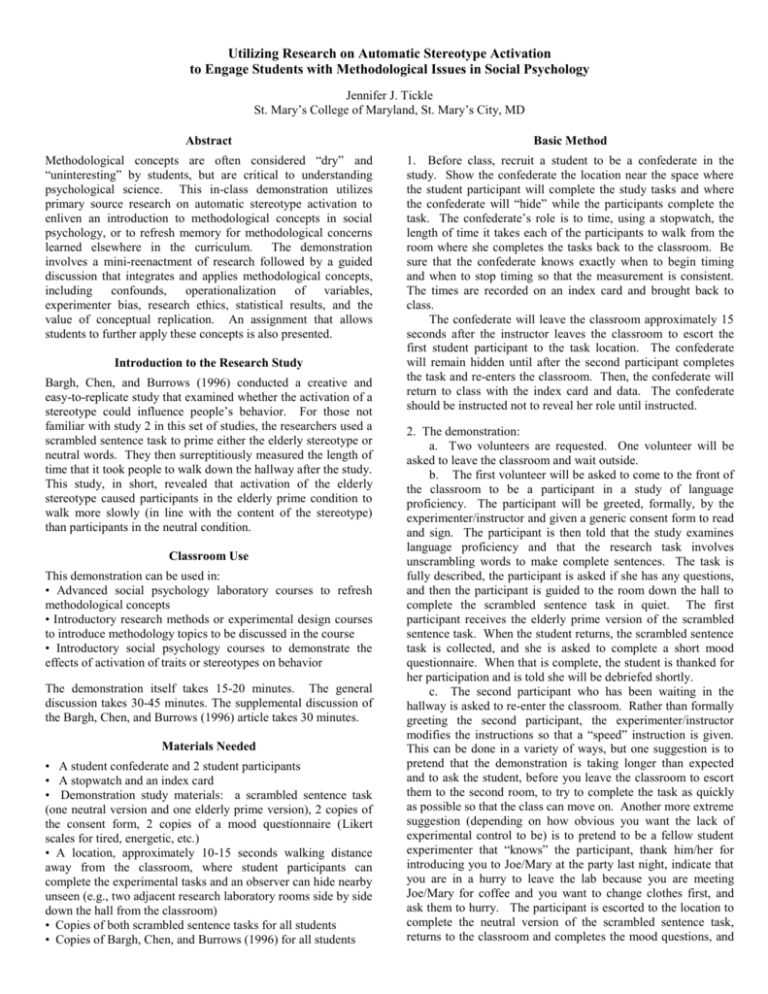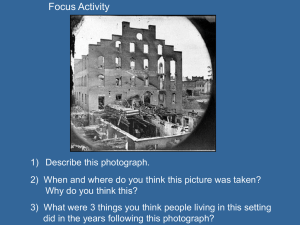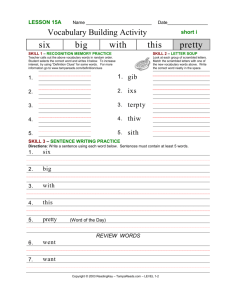tickleSPSP
advertisement

Utilizing Research on Automatic Stereotype Activation to Engage Students with Methodological Issues in Social Psychology Jennifer J. Tickle St. Mary’s College of Maryland, St. Mary’s City, MD Abstract Basic Method Methodological concepts are often considered “dry” and “uninteresting” by students, but are critical to understanding psychological science. This in-class demonstration utilizes primary source research on automatic stereotype activation to enliven an introduction to methodological concepts in social psychology, or to refresh memory for methodological concerns learned elsewhere in the curriculum. The demonstration involves a mini-reenactment of research followed by a guided discussion that integrates and applies methodological concepts, including confounds, operationalization of variables, experimenter bias, research ethics, statistical results, and the value of conceptual replication. An assignment that allows students to further apply these concepts is also presented. 1. Before class, recruit a student to be a confederate in the study. Show the confederate the location near the space where the student participant will complete the study tasks and where the confederate will “hide” while the participants complete the task. The confederate’s role is to time, using a stopwatch, the length of time it takes each of the participants to walk from the room where she completes the tasks back to the classroom. Be sure that the confederate knows exactly when to begin timing and when to stop timing so that the measurement is consistent. The times are recorded on an index card and brought back to class. The confederate will leave the classroom approximately 15 seconds after the instructor leaves the classroom to escort the first student participant to the task location. The confederate will remain hidden until after the second participant completes the task and re-enters the classroom. Then, the confederate will return to class with the index card and data. The confederate should be instructed not to reveal her role until instructed. Introduction to the Research Study Bargh, Chen, and Burrows (1996) conducted a creative and easy-to-replicate study that examined whether the activation of a stereotype could influence people’s behavior. For those not familiar with study 2 in this set of studies, the researchers used a scrambled sentence task to prime either the elderly stereotype or neutral words. They then surreptitiously measured the length of time that it took people to walk down the hallway after the study. This study, in short, revealed that activation of the elderly stereotype caused participants in the elderly prime condition to walk more slowly (in line with the content of the stereotype) than participants in the neutral condition. Classroom Use This demonstration can be used in: • Advanced social psychology laboratory courses to refresh methodological concepts • Introductory research methods or experimental design courses to introduce methodology topics to be discussed in the course • Introductory social psychology courses to demonstrate the effects of activation of traits or stereotypes on behavior The demonstration itself takes 15-20 minutes. The general discussion takes 30-45 minutes. The supplemental discussion of the Bargh, Chen, and Burrows (1996) article takes 30 minutes. Materials Needed • A student confederate and 2 student participants • A stopwatch and an index card • Demonstration study materials: a scrambled sentence task (one neutral version and one elderly prime version), 2 copies of the consent form, 2 copies of a mood questionnaire (Likert scales for tired, energetic, etc.) • A location, approximately 10-15 seconds walking distance away from the classroom, where student participants can complete the experimental tasks and an observer can hide nearby unseen (e.g., two adjacent research laboratory rooms side by side down the hall from the classroom) • Copies of both scrambled sentence tasks for all students • Copies of Bargh, Chen, and Burrows (1996) for all students 2. The demonstration: a. Two volunteers are requested. One volunteer will be asked to leave the classroom and wait outside. b. The first volunteer will be asked to come to the front of the classroom to be a participant in a study of language proficiency. The participant will be greeted, formally, by the experimenter/instructor and given a generic consent form to read and sign. The participant is then told that the study examines language proficiency and that the research task involves unscrambling words to make complete sentences. The task is fully described, the participant is asked if she has any questions, and then the participant is guided to the room down the hall to complete the scrambled sentence task in quiet. The first participant receives the elderly prime version of the scrambled sentence task. When the student returns, the scrambled sentence task is collected, and she is asked to complete a short mood questionnaire. When that is complete, the student is thanked for her participation and is told she will be debriefed shortly. c. The second participant who has been waiting in the hallway is asked to re-enter the classroom. Rather than formally greeting the second participant, the experimenter/instructor modifies the instructions so that a “speed” instruction is given. This can be done in a variety of ways, but one suggestion is to pretend that the demonstration is taking longer than expected and to ask the student, before you leave the classroom to escort them to the second room, to try to complete the task as quickly as possible so that the class can move on. Another more extreme suggestion (depending on how obvious you want the lack of experimental control to be) is to pretend to be a fellow student experimenter that “knows” the participant, thank him/her for introducing you to Joe/Mary at the party last night, indicate that you are in a hurry to leave the lab because you are meeting Joe/Mary for coffee and you want to change clothes first, and ask them to hurry. The participant is escorted to the location to complete the neutral version of the scrambled sentence task, returns to the classroom and completes the mood questions, and is thanked for his/her participation. The confederate should return to the classroom momentarily, ending the demonstration. d. While the participants complete the scrambled sentence tasks, the students in class can be given a general description of the neutral scrambled sentence task (not revealing that there are two versions of it) and can be shown the items on the mood questionnaire. Follow-up Discussion 8. Provide students with a copy of the original Bargh, Chen, and Burrows (1996) article and ask them to read the method section for Study 2. Discuss the differences between the demonstration and the actual study. Discuss the level of detail contained in the Method section and how the study could be easily replicated based on the information provided. Examine the results and Figure 2, and discuss the value of the replication. Also discuss that studies may include additional measures (like the mood measure) to help rule out alternative explanations for the results. The goal of the post-demonstration discussion is to have students critically examine the research demonstration and to refresh or introduce methodological topics and terms. The discussion might proceed by posing the following questions to the students: 9. Walk students through the method and results of studies 1 and 3, discussing the value of conceptual replication and different ways of operationalizing the independent and dependent variables. 1. Before students receive additional information about the experiment, what do they think the goal and hypothesis of this experiment might have been? What was the independent variable? The dependent variable? Usually students will think the type of instruction was the independent variable and mood was the dependent variable. Explore as many hypotheses as they can generate. 10. Discuss the ethics of this research, including the use of deception and cover stories, informed consent, and the “faux” debriefing and real debriefing procedures. 2. Introduce that the type of instruction was not intended to be manipulated. Is this a potential problem for the experiment? Discuss types of error, the importance of experimental control, and the benefits of experimental scripts and standardization. 3. Give students copies of the two versions of the scrambled sentence task and explain that the manipulation of the independent variable is actually contained in that task. What was manipulated in the task? They will begin to notice that some words are different. Is there a theme present in the words? What could the manipulation be doing? Describe the conceptual variable and its operationalization. 4. Revisit what the hypothesis might be given this new knowledge of the independent variable. Students will still refer to the measure of mood as the dependent variable. 5. Tell students that the mood questions were not actually the dependent variable. Ask the confederate to describe her role in the study and ask the students again to revise their hypothesis given the new dependent variable. Move students toward the hypothesis that the elderly prime should have an effect on behavior by decreasing walking speed compared to the neutral task. Discuss the value of different types of dependent measures (e.g, behavioral, self-report). 6. Have the confederate provide the data (the two walking times for the two participants). Regardless of whether the hypothesis is supported (which it almost always is), ask students what can be concluded from the data. Is the hypothesis supported? Points to discuss include the inadequacy of sample size and the need for statistical analysis (in this case, a t-test). A main point to make is that the prime manipulation is confounded by the type of instruction given, therefore an unequivocal causal conclusion cannot be made regarding the effectiveness of the prime. Additional discussion of the role of random assignment and blind experimenters (and confederates) is also valuable. 7. Have students brainstorm alternative ways to operationalize the independent and dependent variables in the study, and then explore alternative ways that the research question could be studied using other stereotypes and behaviors. 11. As a follow-up to the in-class demonstration, instructors can also use a paper assignment intended to have students extend the Bargh, Chen, and Burrows (1996) study in some way. Students can choose to design a conceptual replication, to design a study that addresses an alternative explanation for one of the three studies, or to design a study that addresses one of the issues raised in the article’s discussion. Students write a short introduction to their research study, and then write a thorough method section, modeling that of Bargh and colleagues, to describe their study. Students then write a “Reflection” section to specifically address design decisions they made with regard to impact, control, random assignment and ethics. Assessment and Evaluation To assess the effectiveness of the activity in refreshing methodological terms and understanding the topics discussed, students in an advanced social psychology laboratory course (N = 10) were asked to define or provide examples of 8 research methods terms (e.g., independent variable, random assignment, confound, conceptual replication) and to indicate levels of confidence in their understanding of each of the terms. Students defined or provided correct examples for significantly more of the items at the post-test (M = 6.4, SD = 1.6) than at the pretest (M = 4.5, SD = 1.6), t (9) = 3.77, p < .01. Students were also more confident in their responses on the post-test (M = 6.1, SD = 1.0) than on the pretest (M = 4.6, SD = 1.1), t (9) = 9.87, p <. 01. Informal comments about the activity suggest that it is an engaging and useful way to reintroduce these concepts at the beginning of a semester. Reference Bargh, J. A., Chen, M., & Burrows, L. (1996). Automaticity of social behavior: Direct effects of trait construct and stereotype activation on action. Journal of Personality and Social Psychology, 71 (2), 230-244. For questions or additional information, contact: jjtickle@smcm.edu Presented at the Teaching Pre-conference at the 8th Annual Meeting of the Society for Personality and Social Psychology, Memphis, TN, January 2007








